Analyzing Therapeutic Communication Strategies in Nursing Practice
VerifiedAdded on 2023/04/22
|10
|2941
|91
Report
AI Summary
This report delves into the critical role of therapeutic communication in nursing, emphasizing its significance in establishing effective nurse-patient relationships. The report highlights essential communication techniques, including active listening, respect for cultural differences, and the importance of non-verbal cues like body language and facial expressions. A case study illustrates the impact of both effective and ineffective communication, demonstrating how therapeutic approaches can enhance patient satisfaction and improve health outcomes. The report underscores the ethical principles that underpin therapeutic communication, such as patient autonomy and informed consent. It stresses the importance of cultural competency and the nurse's ability to create an environment of trust, respect, and empathy, ultimately contributing to the patient's overall well-being and recovery. This report showcases how nurses can foster positive patient experiences and build strong therapeutic alliances. You can find more resources and solved assignments on Desklib.
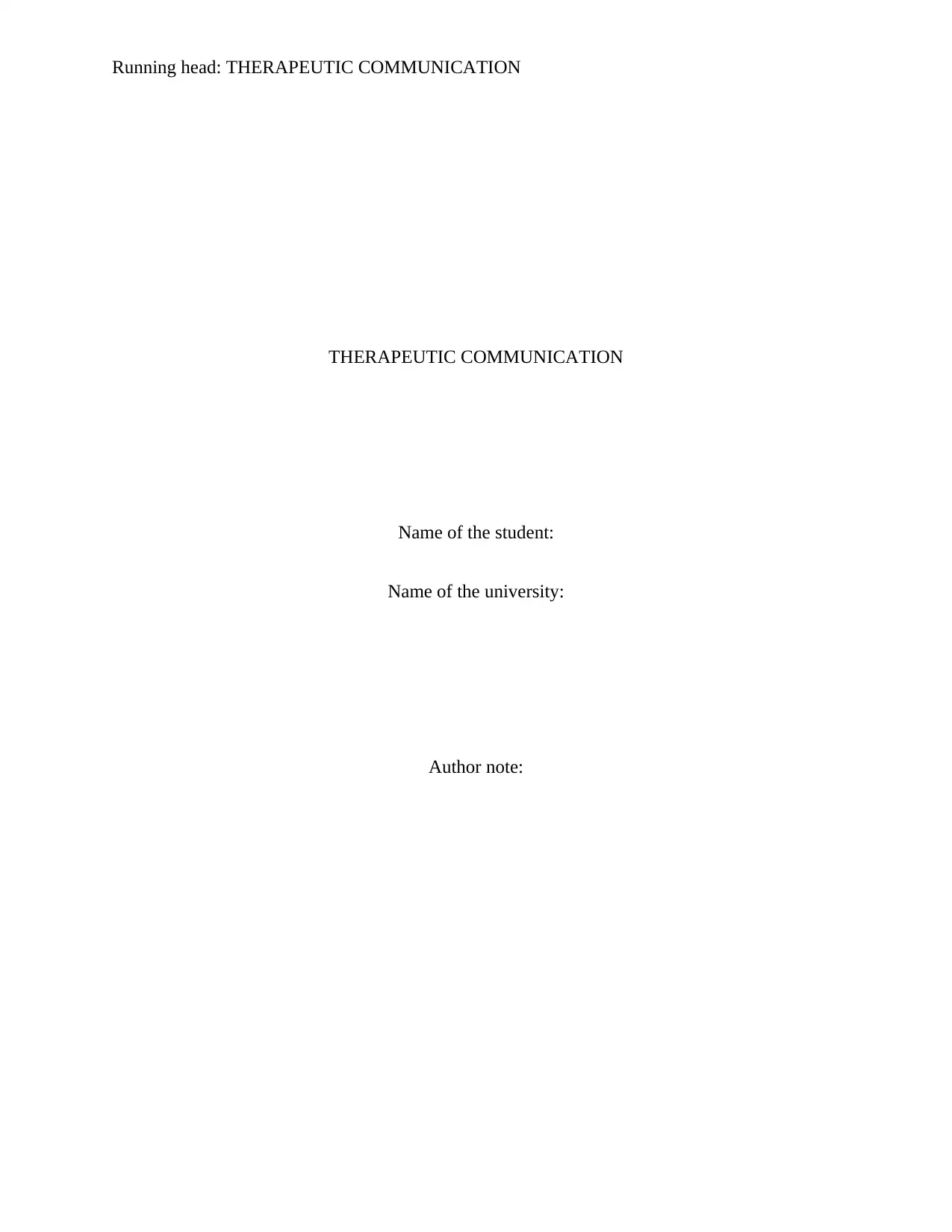
Running head: THERAPEUTIC COMMUNICATION
THERAPEUTIC COMMUNICATION
Name of the student:
Name of the university:
Author note:
THERAPEUTIC COMMUNICATION
Name of the student:
Name of the university:
Author note:
Paraphrase This Document
Need a fresh take? Get an instant paraphrase of this document with our AI Paraphraser
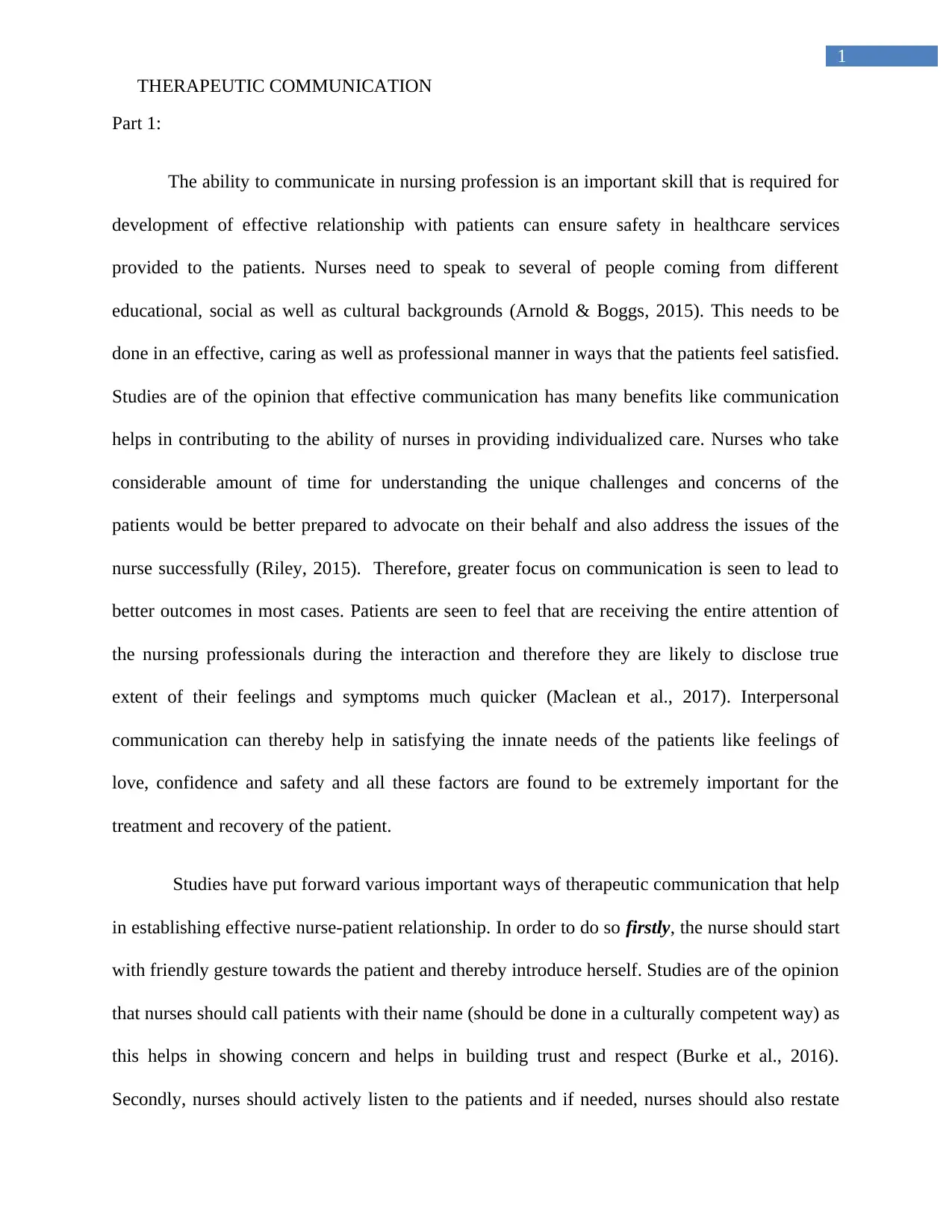
1
THERAPEUTIC COMMUNICATION
Part 1:
The ability to communicate in nursing profession is an important skill that is required for
development of effective relationship with patients can ensure safety in healthcare services
provided to the patients. Nurses need to speak to several of people coming from different
educational, social as well as cultural backgrounds (Arnold & Boggs, 2015). This needs to be
done in an effective, caring as well as professional manner in ways that the patients feel satisfied.
Studies are of the opinion that effective communication has many benefits like communication
helps in contributing to the ability of nurses in providing individualized care. Nurses who take
considerable amount of time for understanding the unique challenges and concerns of the
patients would be better prepared to advocate on their behalf and also address the issues of the
nurse successfully (Riley, 2015). Therefore, greater focus on communication is seen to lead to
better outcomes in most cases. Patients are seen to feel that are receiving the entire attention of
the nursing professionals during the interaction and therefore they are likely to disclose true
extent of their feelings and symptoms much quicker (Maclean et al., 2017). Interpersonal
communication can thereby help in satisfying the innate needs of the patients like feelings of
love, confidence and safety and all these factors are found to be extremely important for the
treatment and recovery of the patient.
Studies have put forward various important ways of therapeutic communication that help
in establishing effective nurse-patient relationship. In order to do so firstly, the nurse should start
with friendly gesture towards the patient and thereby introduce herself. Studies are of the opinion
that nurses should call patients with their name (should be done in a culturally competent way) as
this helps in showing concern and helps in building trust and respect (Burke et al., 2016).
Secondly, nurses should actively listen to the patients and if needed, nurses should also restate
THERAPEUTIC COMMUNICATION
Part 1:
The ability to communicate in nursing profession is an important skill that is required for
development of effective relationship with patients can ensure safety in healthcare services
provided to the patients. Nurses need to speak to several of people coming from different
educational, social as well as cultural backgrounds (Arnold & Boggs, 2015). This needs to be
done in an effective, caring as well as professional manner in ways that the patients feel satisfied.
Studies are of the opinion that effective communication has many benefits like communication
helps in contributing to the ability of nurses in providing individualized care. Nurses who take
considerable amount of time for understanding the unique challenges and concerns of the
patients would be better prepared to advocate on their behalf and also address the issues of the
nurse successfully (Riley, 2015). Therefore, greater focus on communication is seen to lead to
better outcomes in most cases. Patients are seen to feel that are receiving the entire attention of
the nursing professionals during the interaction and therefore they are likely to disclose true
extent of their feelings and symptoms much quicker (Maclean et al., 2017). Interpersonal
communication can thereby help in satisfying the innate needs of the patients like feelings of
love, confidence and safety and all these factors are found to be extremely important for the
treatment and recovery of the patient.
Studies have put forward various important ways of therapeutic communication that help
in establishing effective nurse-patient relationship. In order to do so firstly, the nurse should start
with friendly gesture towards the patient and thereby introduce herself. Studies are of the opinion
that nurses should call patients with their name (should be done in a culturally competent way) as
this helps in showing concern and helps in building trust and respect (Burke et al., 2016).
Secondly, nurses should actively listen to the patients and if needed, nurses should also restate
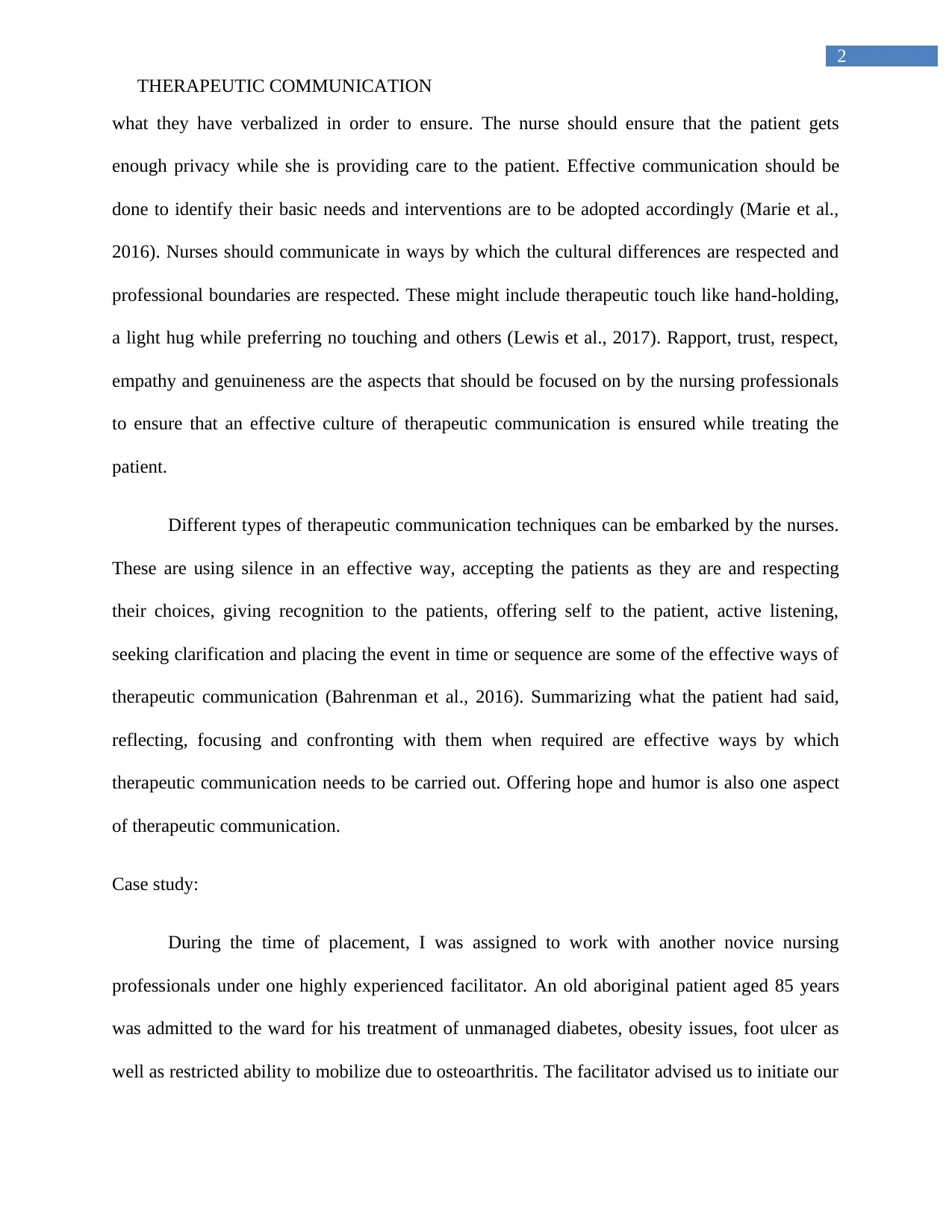
2
THERAPEUTIC COMMUNICATION
what they have verbalized in order to ensure. The nurse should ensure that the patient gets
enough privacy while she is providing care to the patient. Effective communication should be
done to identify their basic needs and interventions are to be adopted accordingly (Marie et al.,
2016). Nurses should communicate in ways by which the cultural differences are respected and
professional boundaries are respected. These might include therapeutic touch like hand-holding,
a light hug while preferring no touching and others (Lewis et al., 2017). Rapport, trust, respect,
empathy and genuineness are the aspects that should be focused on by the nursing professionals
to ensure that an effective culture of therapeutic communication is ensured while treating the
patient.
Different types of therapeutic communication techniques can be embarked by the nurses.
These are using silence in an effective way, accepting the patients as they are and respecting
their choices, giving recognition to the patients, offering self to the patient, active listening,
seeking clarification and placing the event in time or sequence are some of the effective ways of
therapeutic communication (Bahrenman et al., 2016). Summarizing what the patient had said,
reflecting, focusing and confronting with them when required are effective ways by which
therapeutic communication needs to be carried out. Offering hope and humor is also one aspect
of therapeutic communication.
Case study:
During the time of placement, I was assigned to work with another novice nursing
professionals under one highly experienced facilitator. An old aboriginal patient aged 85 years
was admitted to the ward for his treatment of unmanaged diabetes, obesity issues, foot ulcer as
well as restricted ability to mobilize due to osteoarthritis. The facilitator advised us to initiate our
THERAPEUTIC COMMUNICATION
what they have verbalized in order to ensure. The nurse should ensure that the patient gets
enough privacy while she is providing care to the patient. Effective communication should be
done to identify their basic needs and interventions are to be adopted accordingly (Marie et al.,
2016). Nurses should communicate in ways by which the cultural differences are respected and
professional boundaries are respected. These might include therapeutic touch like hand-holding,
a light hug while preferring no touching and others (Lewis et al., 2017). Rapport, trust, respect,
empathy and genuineness are the aspects that should be focused on by the nursing professionals
to ensure that an effective culture of therapeutic communication is ensured while treating the
patient.
Different types of therapeutic communication techniques can be embarked by the nurses.
These are using silence in an effective way, accepting the patients as they are and respecting
their choices, giving recognition to the patients, offering self to the patient, active listening,
seeking clarification and placing the event in time or sequence are some of the effective ways of
therapeutic communication (Bahrenman et al., 2016). Summarizing what the patient had said,
reflecting, focusing and confronting with them when required are effective ways by which
therapeutic communication needs to be carried out. Offering hope and humor is also one aspect
of therapeutic communication.
Case study:
During the time of placement, I was assigned to work with another novice nursing
professionals under one highly experienced facilitator. An old aboriginal patient aged 85 years
was admitted to the ward for his treatment of unmanaged diabetes, obesity issues, foot ulcer as
well as restricted ability to mobilize due to osteoarthritis. The facilitator advised us to initiate our
⊘ This is a preview!⊘
Do you want full access?
Subscribe today to unlock all pages.

Trusted by 1+ million students worldwide
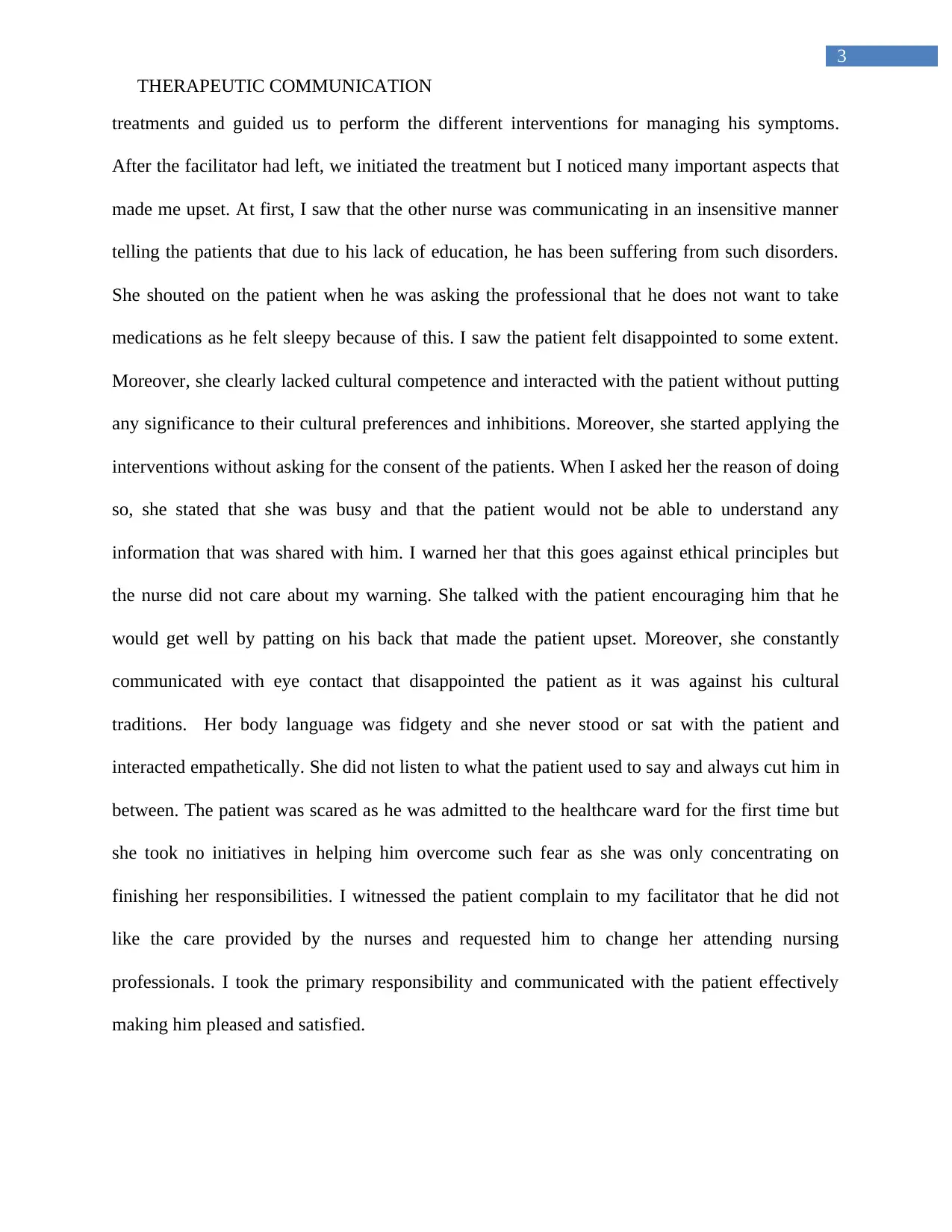
3
THERAPEUTIC COMMUNICATION
treatments and guided us to perform the different interventions for managing his symptoms.
After the facilitator had left, we initiated the treatment but I noticed many important aspects that
made me upset. At first, I saw that the other nurse was communicating in an insensitive manner
telling the patients that due to his lack of education, he has been suffering from such disorders.
She shouted on the patient when he was asking the professional that he does not want to take
medications as he felt sleepy because of this. I saw the patient felt disappointed to some extent.
Moreover, she clearly lacked cultural competence and interacted with the patient without putting
any significance to their cultural preferences and inhibitions. Moreover, she started applying the
interventions without asking for the consent of the patients. When I asked her the reason of doing
so, she stated that she was busy and that the patient would not be able to understand any
information that was shared with him. I warned her that this goes against ethical principles but
the nurse did not care about my warning. She talked with the patient encouraging him that he
would get well by patting on his back that made the patient upset. Moreover, she constantly
communicated with eye contact that disappointed the patient as it was against his cultural
traditions. Her body language was fidgety and she never stood or sat with the patient and
interacted empathetically. She did not listen to what the patient used to say and always cut him in
between. The patient was scared as he was admitted to the healthcare ward for the first time but
she took no initiatives in helping him overcome such fear as she was only concentrating on
finishing her responsibilities. I witnessed the patient complain to my facilitator that he did not
like the care provided by the nurses and requested him to change her attending nursing
professionals. I took the primary responsibility and communicated with the patient effectively
making him pleased and satisfied.
THERAPEUTIC COMMUNICATION
treatments and guided us to perform the different interventions for managing his symptoms.
After the facilitator had left, we initiated the treatment but I noticed many important aspects that
made me upset. At first, I saw that the other nurse was communicating in an insensitive manner
telling the patients that due to his lack of education, he has been suffering from such disorders.
She shouted on the patient when he was asking the professional that he does not want to take
medications as he felt sleepy because of this. I saw the patient felt disappointed to some extent.
Moreover, she clearly lacked cultural competence and interacted with the patient without putting
any significance to their cultural preferences and inhibitions. Moreover, she started applying the
interventions without asking for the consent of the patients. When I asked her the reason of doing
so, she stated that she was busy and that the patient would not be able to understand any
information that was shared with him. I warned her that this goes against ethical principles but
the nurse did not care about my warning. She talked with the patient encouraging him that he
would get well by patting on his back that made the patient upset. Moreover, she constantly
communicated with eye contact that disappointed the patient as it was against his cultural
traditions. Her body language was fidgety and she never stood or sat with the patient and
interacted empathetically. She did not listen to what the patient used to say and always cut him in
between. The patient was scared as he was admitted to the healthcare ward for the first time but
she took no initiatives in helping him overcome such fear as she was only concentrating on
finishing her responsibilities. I witnessed the patient complain to my facilitator that he did not
like the care provided by the nurses and requested him to change her attending nursing
professionals. I took the primary responsibility and communicated with the patient effectively
making him pleased and satisfied.
Paraphrase This Document
Need a fresh take? Get an instant paraphrase of this document with our AI Paraphraser
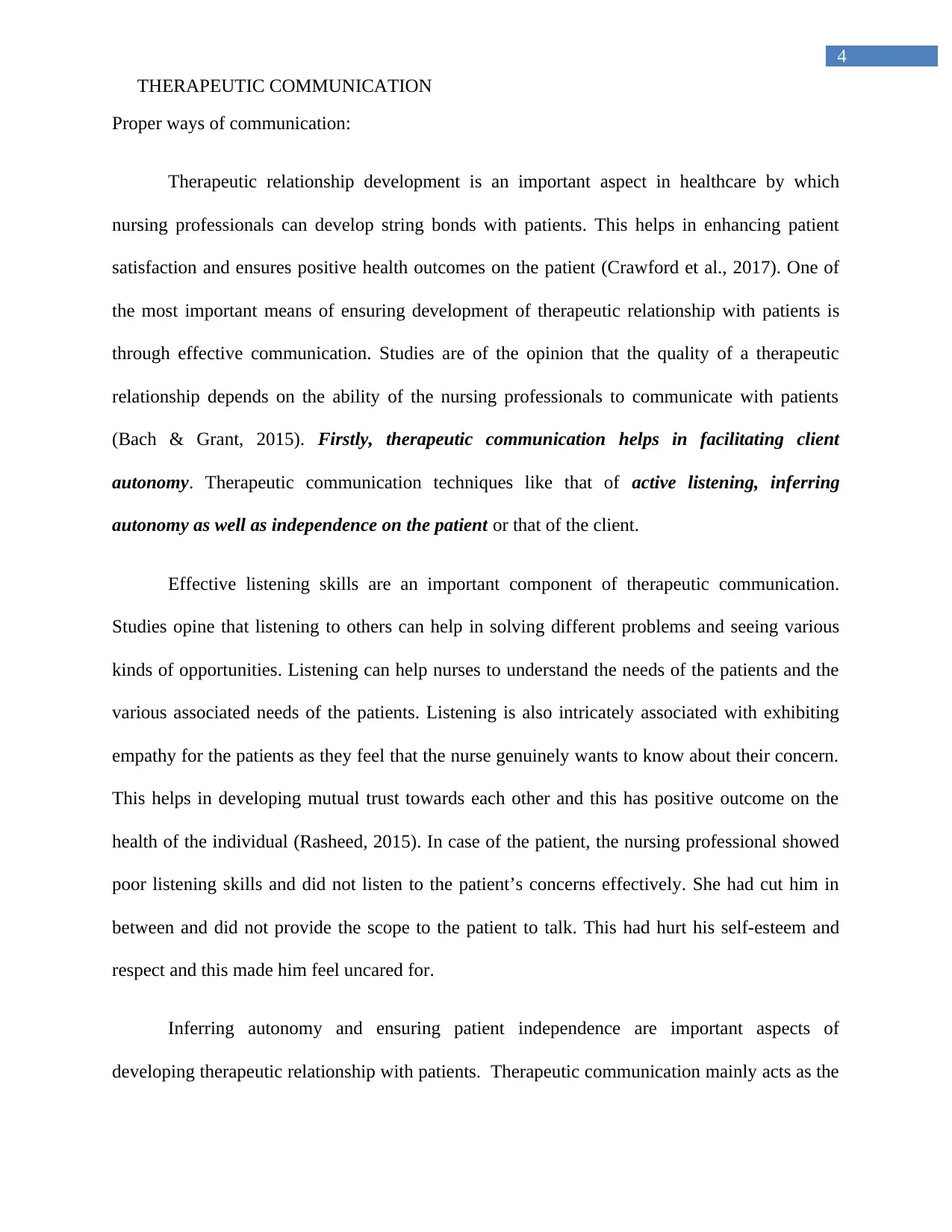
4
THERAPEUTIC COMMUNICATION
Proper ways of communication:
Therapeutic relationship development is an important aspect in healthcare by which
nursing professionals can develop string bonds with patients. This helps in enhancing patient
satisfaction and ensures positive health outcomes on the patient (Crawford et al., 2017). One of
the most important means of ensuring development of therapeutic relationship with patients is
through effective communication. Studies are of the opinion that the quality of a therapeutic
relationship depends on the ability of the nursing professionals to communicate with patients
(Bach & Grant, 2015). Firstly, therapeutic communication helps in facilitating client
autonomy. Therapeutic communication techniques like that of active listening, inferring
autonomy as well as independence on the patient or that of the client.
Effective listening skills are an important component of therapeutic communication.
Studies opine that listening to others can help in solving different problems and seeing various
kinds of opportunities. Listening can help nurses to understand the needs of the patients and the
various associated needs of the patients. Listening is also intricately associated with exhibiting
empathy for the patients as they feel that the nurse genuinely wants to know about their concern.
This helps in developing mutual trust towards each other and this has positive outcome on the
health of the individual (Rasheed, 2015). In case of the patient, the nursing professional showed
poor listening skills and did not listen to the patient’s concerns effectively. She had cut him in
between and did not provide the scope to the patient to talk. This had hurt his self-esteem and
respect and this made him feel uncared for.
Inferring autonomy and ensuring patient independence are important aspects of
developing therapeutic relationship with patients. Therapeutic communication mainly acts as the
THERAPEUTIC COMMUNICATION
Proper ways of communication:
Therapeutic relationship development is an important aspect in healthcare by which
nursing professionals can develop string bonds with patients. This helps in enhancing patient
satisfaction and ensures positive health outcomes on the patient (Crawford et al., 2017). One of
the most important means of ensuring development of therapeutic relationship with patients is
through effective communication. Studies are of the opinion that the quality of a therapeutic
relationship depends on the ability of the nursing professionals to communicate with patients
(Bach & Grant, 2015). Firstly, therapeutic communication helps in facilitating client
autonomy. Therapeutic communication techniques like that of active listening, inferring
autonomy as well as independence on the patient or that of the client.
Effective listening skills are an important component of therapeutic communication.
Studies opine that listening to others can help in solving different problems and seeing various
kinds of opportunities. Listening can help nurses to understand the needs of the patients and the
various associated needs of the patients. Listening is also intricately associated with exhibiting
empathy for the patients as they feel that the nurse genuinely wants to know about their concern.
This helps in developing mutual trust towards each other and this has positive outcome on the
health of the individual (Rasheed, 2015). In case of the patient, the nursing professional showed
poor listening skills and did not listen to the patient’s concerns effectively. She had cut him in
between and did not provide the scope to the patient to talk. This had hurt his self-esteem and
respect and this made him feel uncared for.
Inferring autonomy and ensuring patient independence are important aspects of
developing therapeutic relationship with patients. Therapeutic communication mainly acts as the
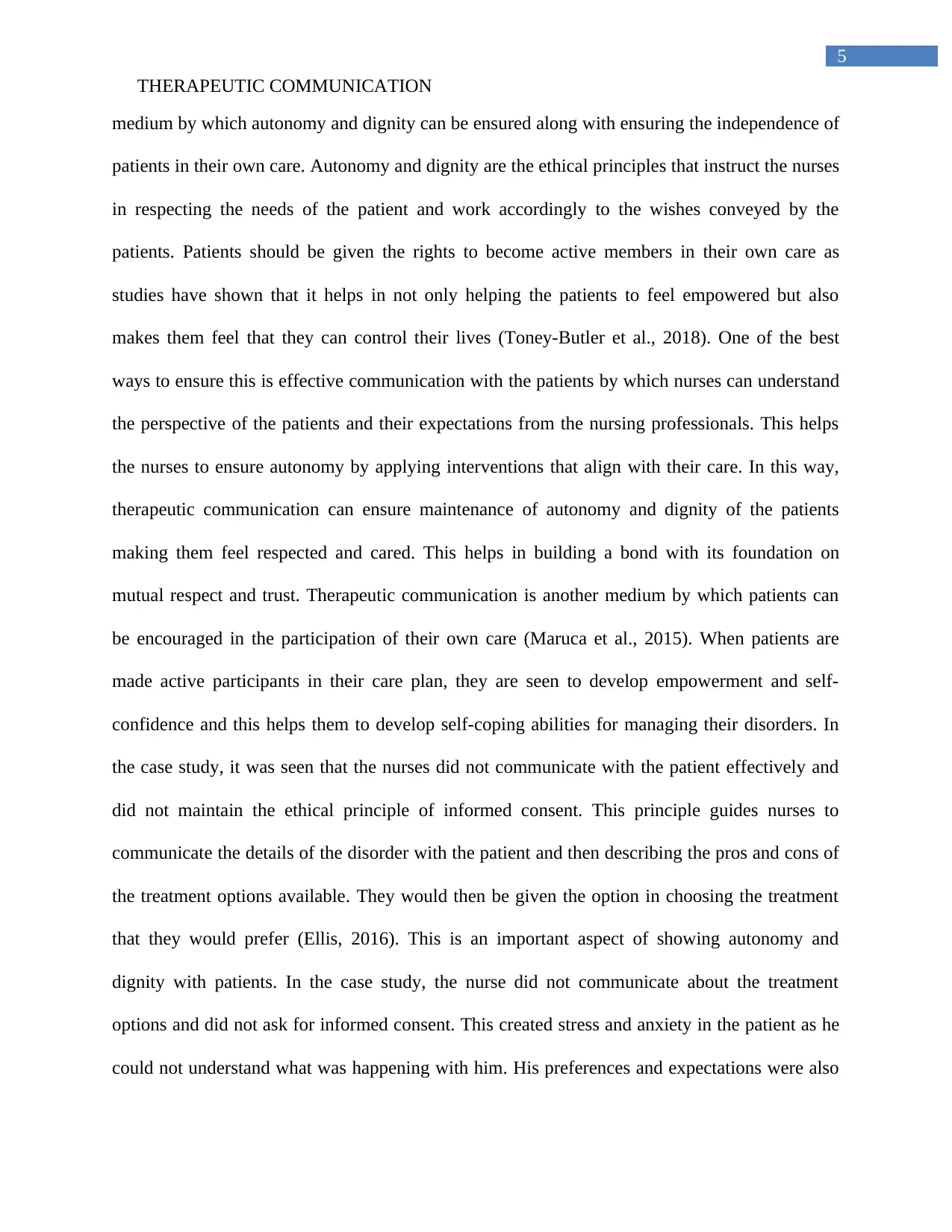
5
THERAPEUTIC COMMUNICATION
medium by which autonomy and dignity can be ensured along with ensuring the independence of
patients in their own care. Autonomy and dignity are the ethical principles that instruct the nurses
in respecting the needs of the patient and work accordingly to the wishes conveyed by the
patients. Patients should be given the rights to become active members in their own care as
studies have shown that it helps in not only helping the patients to feel empowered but also
makes them feel that they can control their lives (Toney-Butler et al., 2018). One of the best
ways to ensure this is effective communication with the patients by which nurses can understand
the perspective of the patients and their expectations from the nursing professionals. This helps
the nurses to ensure autonomy by applying interventions that align with their care. In this way,
therapeutic communication can ensure maintenance of autonomy and dignity of the patients
making them feel respected and cared. This helps in building a bond with its foundation on
mutual respect and trust. Therapeutic communication is another medium by which patients can
be encouraged in the participation of their own care (Maruca et al., 2015). When patients are
made active participants in their care plan, they are seen to develop empowerment and self-
confidence and this helps them to develop self-coping abilities for managing their disorders. In
the case study, it was seen that the nurses did not communicate with the patient effectively and
did not maintain the ethical principle of informed consent. This principle guides nurses to
communicate the details of the disorder with the patient and then describing the pros and cons of
the treatment options available. They would then be given the option in choosing the treatment
that they would prefer (Ellis, 2016). This is an important aspect of showing autonomy and
dignity with patients. In the case study, the nurse did not communicate about the treatment
options and did not ask for informed consent. This created stress and anxiety in the patient as he
could not understand what was happening with him. His preferences and expectations were also
THERAPEUTIC COMMUNICATION
medium by which autonomy and dignity can be ensured along with ensuring the independence of
patients in their own care. Autonomy and dignity are the ethical principles that instruct the nurses
in respecting the needs of the patient and work accordingly to the wishes conveyed by the
patients. Patients should be given the rights to become active members in their own care as
studies have shown that it helps in not only helping the patients to feel empowered but also
makes them feel that they can control their lives (Toney-Butler et al., 2018). One of the best
ways to ensure this is effective communication with the patients by which nurses can understand
the perspective of the patients and their expectations from the nursing professionals. This helps
the nurses to ensure autonomy by applying interventions that align with their care. In this way,
therapeutic communication can ensure maintenance of autonomy and dignity of the patients
making them feel respected and cared. This helps in building a bond with its foundation on
mutual respect and trust. Therapeutic communication is another medium by which patients can
be encouraged in the participation of their own care (Maruca et al., 2015). When patients are
made active participants in their care plan, they are seen to develop empowerment and self-
confidence and this helps them to develop self-coping abilities for managing their disorders. In
the case study, it was seen that the nurses did not communicate with the patient effectively and
did not maintain the ethical principle of informed consent. This principle guides nurses to
communicate the details of the disorder with the patient and then describing the pros and cons of
the treatment options available. They would then be given the option in choosing the treatment
that they would prefer (Ellis, 2016). This is an important aspect of showing autonomy and
dignity with patients. In the case study, the nurse did not communicate about the treatment
options and did not ask for informed consent. This created stress and anxiety in the patient as he
could not understand what was happening with him. His preferences and expectations were also
⊘ This is a preview!⊘
Do you want full access?
Subscribe today to unlock all pages.

Trusted by 1+ million students worldwide
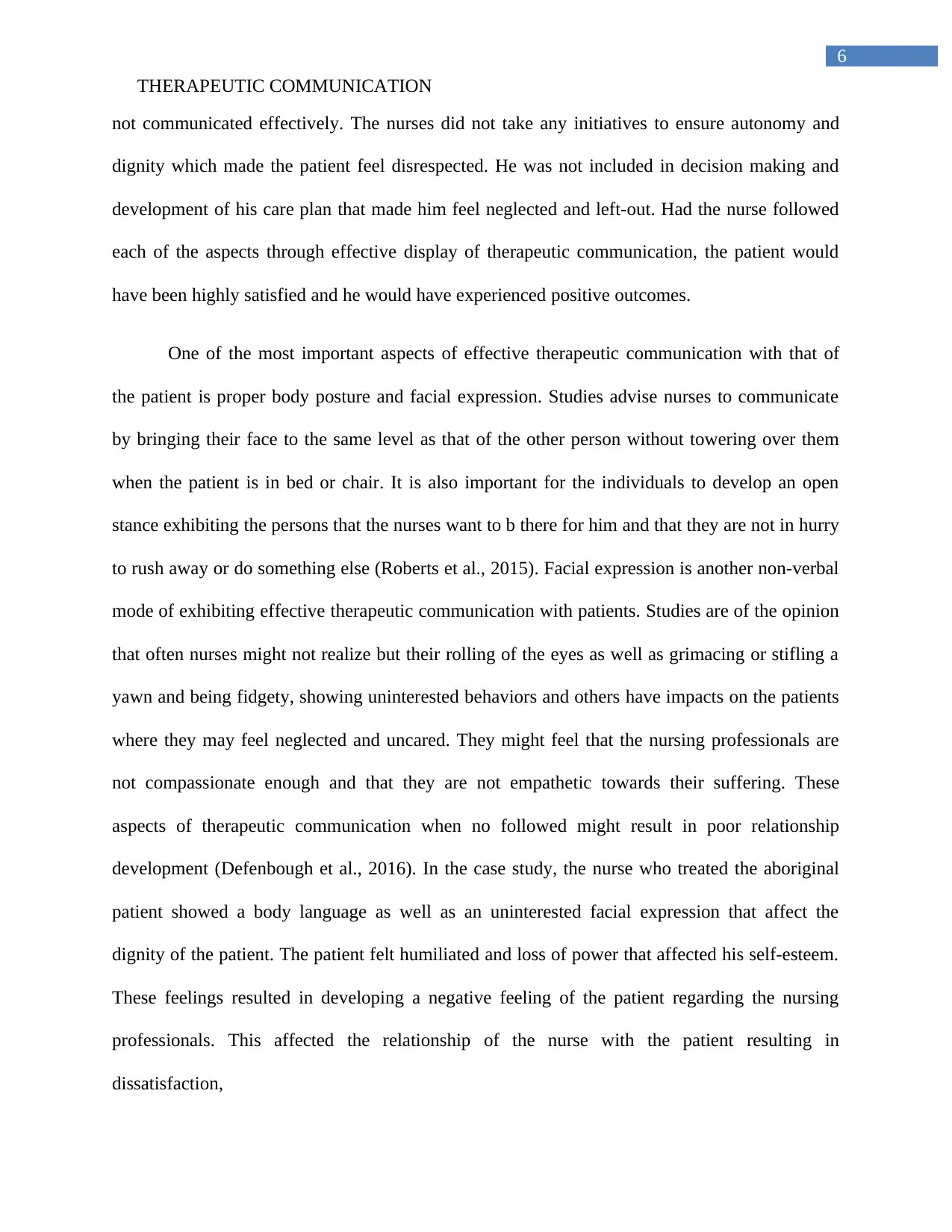
6
THERAPEUTIC COMMUNICATION
not communicated effectively. The nurses did not take any initiatives to ensure autonomy and
dignity which made the patient feel disrespected. He was not included in decision making and
development of his care plan that made him feel neglected and left-out. Had the nurse followed
each of the aspects through effective display of therapeutic communication, the patient would
have been highly satisfied and he would have experienced positive outcomes.
One of the most important aspects of effective therapeutic communication with that of
the patient is proper body posture and facial expression. Studies advise nurses to communicate
by bringing their face to the same level as that of the other person without towering over them
when the patient is in bed or chair. It is also important for the individuals to develop an open
stance exhibiting the persons that the nurses want to b there for him and that they are not in hurry
to rush away or do something else (Roberts et al., 2015). Facial expression is another non-verbal
mode of exhibiting effective therapeutic communication with patients. Studies are of the opinion
that often nurses might not realize but their rolling of the eyes as well as grimacing or stifling a
yawn and being fidgety, showing uninterested behaviors and others have impacts on the patients
where they may feel neglected and uncared. They might feel that the nursing professionals are
not compassionate enough and that they are not empathetic towards their suffering. These
aspects of therapeutic communication when no followed might result in poor relationship
development (Defenbough et al., 2016). In the case study, the nurse who treated the aboriginal
patient showed a body language as well as an uninterested facial expression that affect the
dignity of the patient. The patient felt humiliated and loss of power that affected his self-esteem.
These feelings resulted in developing a negative feeling of the patient regarding the nursing
professionals. This affected the relationship of the nurse with the patient resulting in
dissatisfaction,
THERAPEUTIC COMMUNICATION
not communicated effectively. The nurses did not take any initiatives to ensure autonomy and
dignity which made the patient feel disrespected. He was not included in decision making and
development of his care plan that made him feel neglected and left-out. Had the nurse followed
each of the aspects through effective display of therapeutic communication, the patient would
have been highly satisfied and he would have experienced positive outcomes.
One of the most important aspects of effective therapeutic communication with that of
the patient is proper body posture and facial expression. Studies advise nurses to communicate
by bringing their face to the same level as that of the other person without towering over them
when the patient is in bed or chair. It is also important for the individuals to develop an open
stance exhibiting the persons that the nurses want to b there for him and that they are not in hurry
to rush away or do something else (Roberts et al., 2015). Facial expression is another non-verbal
mode of exhibiting effective therapeutic communication with patients. Studies are of the opinion
that often nurses might not realize but their rolling of the eyes as well as grimacing or stifling a
yawn and being fidgety, showing uninterested behaviors and others have impacts on the patients
where they may feel neglected and uncared. They might feel that the nursing professionals are
not compassionate enough and that they are not empathetic towards their suffering. These
aspects of therapeutic communication when no followed might result in poor relationship
development (Defenbough et al., 2016). In the case study, the nurse who treated the aboriginal
patient showed a body language as well as an uninterested facial expression that affect the
dignity of the patient. The patient felt humiliated and loss of power that affected his self-esteem.
These feelings resulted in developing a negative feeling of the patient regarding the nursing
professionals. This affected the relationship of the nurse with the patient resulting in
dissatisfaction,
Paraphrase This Document
Need a fresh take? Get an instant paraphrase of this document with our AI Paraphraser
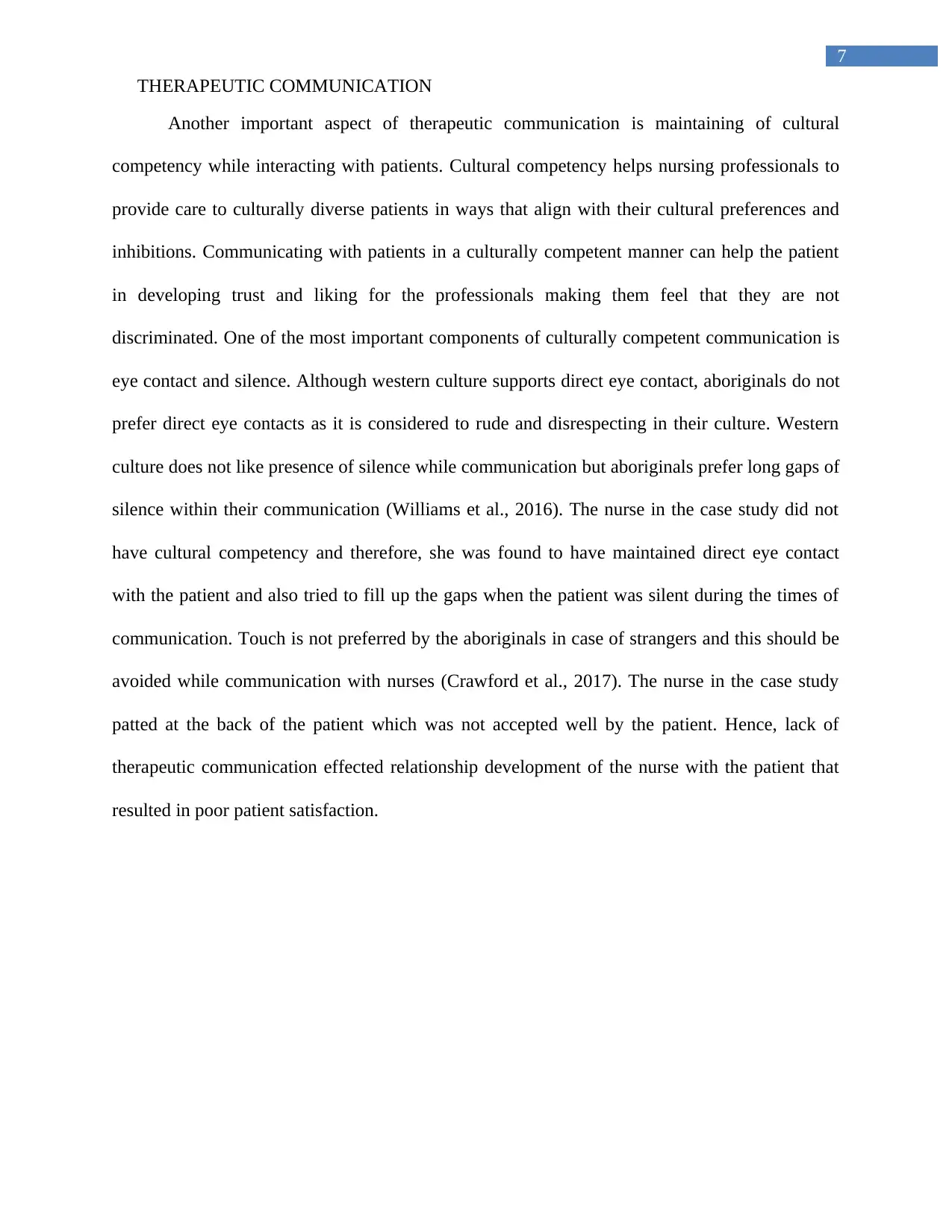
7
THERAPEUTIC COMMUNICATION
Another important aspect of therapeutic communication is maintaining of cultural
competency while interacting with patients. Cultural competency helps nursing professionals to
provide care to culturally diverse patients in ways that align with their cultural preferences and
inhibitions. Communicating with patients in a culturally competent manner can help the patient
in developing trust and liking for the professionals making them feel that they are not
discriminated. One of the most important components of culturally competent communication is
eye contact and silence. Although western culture supports direct eye contact, aboriginals do not
prefer direct eye contacts as it is considered to rude and disrespecting in their culture. Western
culture does not like presence of silence while communication but aboriginals prefer long gaps of
silence within their communication (Williams et al., 2016). The nurse in the case study did not
have cultural competency and therefore, she was found to have maintained direct eye contact
with the patient and also tried to fill up the gaps when the patient was silent during the times of
communication. Touch is not preferred by the aboriginals in case of strangers and this should be
avoided while communication with nurses (Crawford et al., 2017). The nurse in the case study
patted at the back of the patient which was not accepted well by the patient. Hence, lack of
therapeutic communication effected relationship development of the nurse with the patient that
resulted in poor patient satisfaction.
THERAPEUTIC COMMUNICATION
Another important aspect of therapeutic communication is maintaining of cultural
competency while interacting with patients. Cultural competency helps nursing professionals to
provide care to culturally diverse patients in ways that align with their cultural preferences and
inhibitions. Communicating with patients in a culturally competent manner can help the patient
in developing trust and liking for the professionals making them feel that they are not
discriminated. One of the most important components of culturally competent communication is
eye contact and silence. Although western culture supports direct eye contact, aboriginals do not
prefer direct eye contacts as it is considered to rude and disrespecting in their culture. Western
culture does not like presence of silence while communication but aboriginals prefer long gaps of
silence within their communication (Williams et al., 2016). The nurse in the case study did not
have cultural competency and therefore, she was found to have maintained direct eye contact
with the patient and also tried to fill up the gaps when the patient was silent during the times of
communication. Touch is not preferred by the aboriginals in case of strangers and this should be
avoided while communication with nurses (Crawford et al., 2017). The nurse in the case study
patted at the back of the patient which was not accepted well by the patient. Hence, lack of
therapeutic communication effected relationship development of the nurse with the patient that
resulted in poor patient satisfaction.
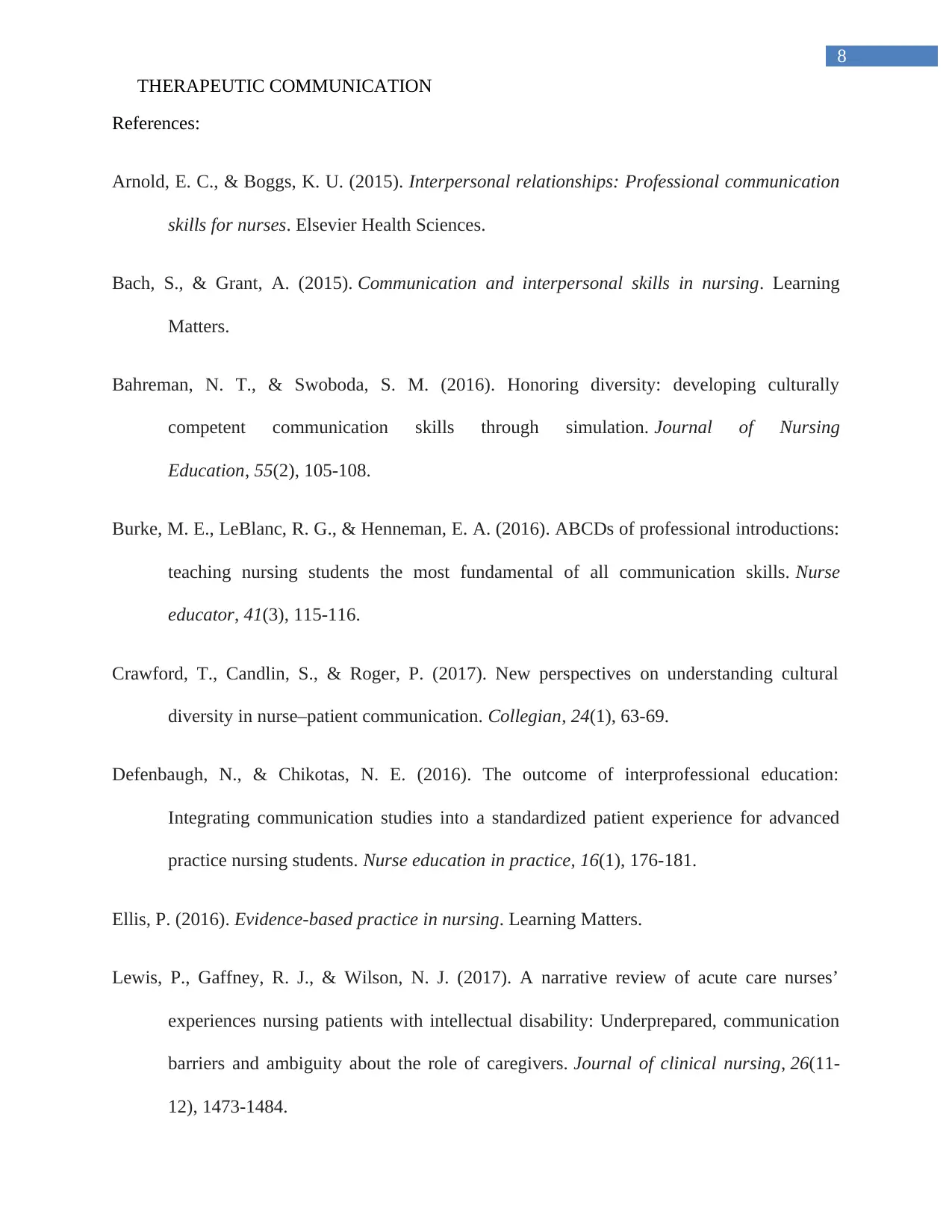
8
THERAPEUTIC COMMUNICATION
References:
Arnold, E. C., & Boggs, K. U. (2015). Interpersonal relationships: Professional communication
skills for nurses. Elsevier Health Sciences.
Bach, S., & Grant, A. (2015). Communication and interpersonal skills in nursing. Learning
Matters.
Bahreman, N. T., & Swoboda, S. M. (2016). Honoring diversity: developing culturally
competent communication skills through simulation. Journal of Nursing
Education, 55(2), 105-108.
Burke, M. E., LeBlanc, R. G., & Henneman, E. A. (2016). ABCDs of professional introductions:
teaching nursing students the most fundamental of all communication skills. Nurse
educator, 41(3), 115-116.
Crawford, T., Candlin, S., & Roger, P. (2017). New perspectives on understanding cultural
diversity in nurse–patient communication. Collegian, 24(1), 63-69.
Defenbaugh, N., & Chikotas, N. E. (2016). The outcome of interprofessional education:
Integrating communication studies into a standardized patient experience for advanced
practice nursing students. Nurse education in practice, 16(1), 176-181.
Ellis, P. (2016). Evidence-based practice in nursing. Learning Matters.
Lewis, P., Gaffney, R. J., & Wilson, N. J. (2017). A narrative review of acute care nurses’
experiences nursing patients with intellectual disability: Underprepared, communication
barriers and ambiguity about the role of caregivers. Journal of clinical nursing, 26(11-
12), 1473-1484.
THERAPEUTIC COMMUNICATION
References:
Arnold, E. C., & Boggs, K. U. (2015). Interpersonal relationships: Professional communication
skills for nurses. Elsevier Health Sciences.
Bach, S., & Grant, A. (2015). Communication and interpersonal skills in nursing. Learning
Matters.
Bahreman, N. T., & Swoboda, S. M. (2016). Honoring diversity: developing culturally
competent communication skills through simulation. Journal of Nursing
Education, 55(2), 105-108.
Burke, M. E., LeBlanc, R. G., & Henneman, E. A. (2016). ABCDs of professional introductions:
teaching nursing students the most fundamental of all communication skills. Nurse
educator, 41(3), 115-116.
Crawford, T., Candlin, S., & Roger, P. (2017). New perspectives on understanding cultural
diversity in nurse–patient communication. Collegian, 24(1), 63-69.
Defenbaugh, N., & Chikotas, N. E. (2016). The outcome of interprofessional education:
Integrating communication studies into a standardized patient experience for advanced
practice nursing students. Nurse education in practice, 16(1), 176-181.
Ellis, P. (2016). Evidence-based practice in nursing. Learning Matters.
Lewis, P., Gaffney, R. J., & Wilson, N. J. (2017). A narrative review of acute care nurses’
experiences nursing patients with intellectual disability: Underprepared, communication
barriers and ambiguity about the role of caregivers. Journal of clinical nursing, 26(11-
12), 1473-1484.
⊘ This is a preview!⊘
Do you want full access?
Subscribe today to unlock all pages.

Trusted by 1+ million students worldwide
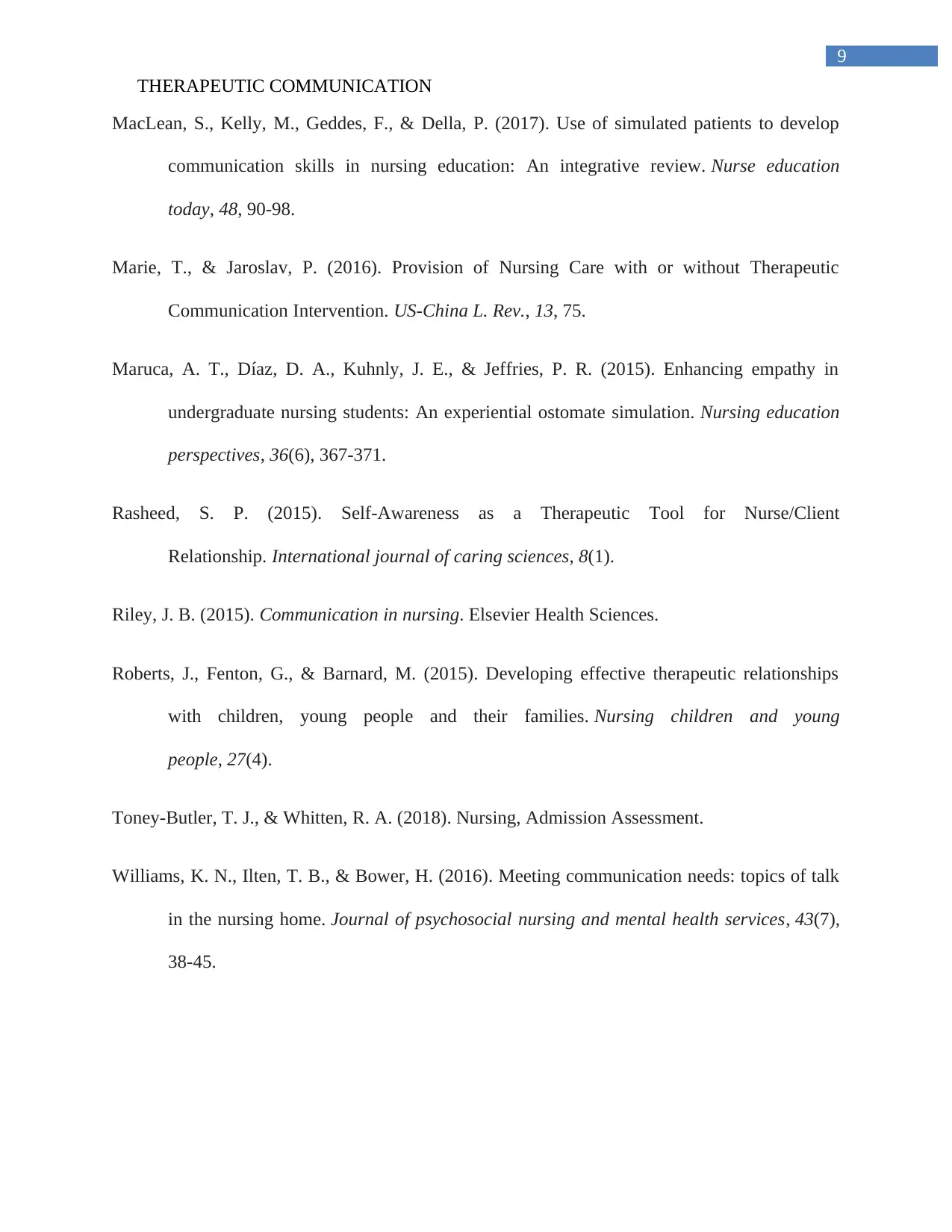
9
THERAPEUTIC COMMUNICATION
MacLean, S., Kelly, M., Geddes, F., & Della, P. (2017). Use of simulated patients to develop
communication skills in nursing education: An integrative review. Nurse education
today, 48, 90-98.
Marie, T., & Jaroslav, P. (2016). Provision of Nursing Care with or without Therapeutic
Communication Intervention. US-China L. Rev., 13, 75.
Maruca, A. T., Díaz, D. A., Kuhnly, J. E., & Jeffries, P. R. (2015). Enhancing empathy in
undergraduate nursing students: An experiential ostomate simulation. Nursing education
perspectives, 36(6), 367-371.
Rasheed, S. P. (2015). Self-Awareness as a Therapeutic Tool for Nurse/Client
Relationship. International journal of caring sciences, 8(1).
Riley, J. B. (2015). Communication in nursing. Elsevier Health Sciences.
Roberts, J., Fenton, G., & Barnard, M. (2015). Developing effective therapeutic relationships
with children, young people and their families. Nursing children and young
people, 27(4).
Toney-Butler, T. J., & Whitten, R. A. (2018). Nursing, Admission Assessment.
Williams, K. N., Ilten, T. B., & Bower, H. (2016). Meeting communication needs: topics of talk
in the nursing home. Journal of psychosocial nursing and mental health services, 43(7),
38-45.
THERAPEUTIC COMMUNICATION
MacLean, S., Kelly, M., Geddes, F., & Della, P. (2017). Use of simulated patients to develop
communication skills in nursing education: An integrative review. Nurse education
today, 48, 90-98.
Marie, T., & Jaroslav, P. (2016). Provision of Nursing Care with or without Therapeutic
Communication Intervention. US-China L. Rev., 13, 75.
Maruca, A. T., Díaz, D. A., Kuhnly, J. E., & Jeffries, P. R. (2015). Enhancing empathy in
undergraduate nursing students: An experiential ostomate simulation. Nursing education
perspectives, 36(6), 367-371.
Rasheed, S. P. (2015). Self-Awareness as a Therapeutic Tool for Nurse/Client
Relationship. International journal of caring sciences, 8(1).
Riley, J. B. (2015). Communication in nursing. Elsevier Health Sciences.
Roberts, J., Fenton, G., & Barnard, M. (2015). Developing effective therapeutic relationships
with children, young people and their families. Nursing children and young
people, 27(4).
Toney-Butler, T. J., & Whitten, R. A. (2018). Nursing, Admission Assessment.
Williams, K. N., Ilten, T. B., & Bower, H. (2016). Meeting communication needs: topics of talk
in the nursing home. Journal of psychosocial nursing and mental health services, 43(7),
38-45.
1 out of 10
Related Documents
Your All-in-One AI-Powered Toolkit for Academic Success.
+13062052269
info@desklib.com
Available 24*7 on WhatsApp / Email
![[object Object]](/_next/static/media/star-bottom.7253800d.svg)
Unlock your academic potential
Copyright © 2020–2025 A2Z Services. All Rights Reserved. Developed and managed by ZUCOL.





